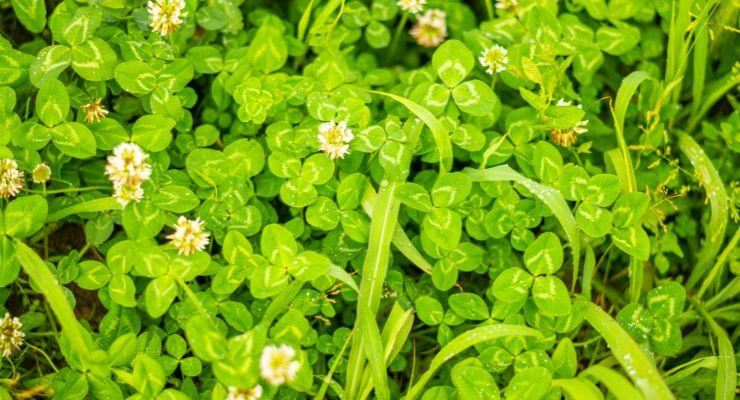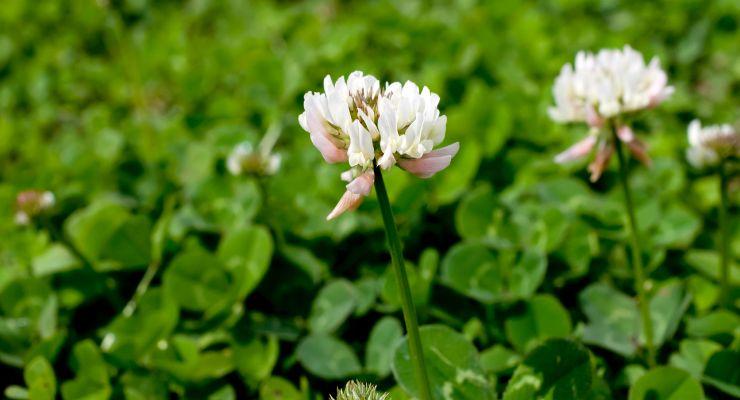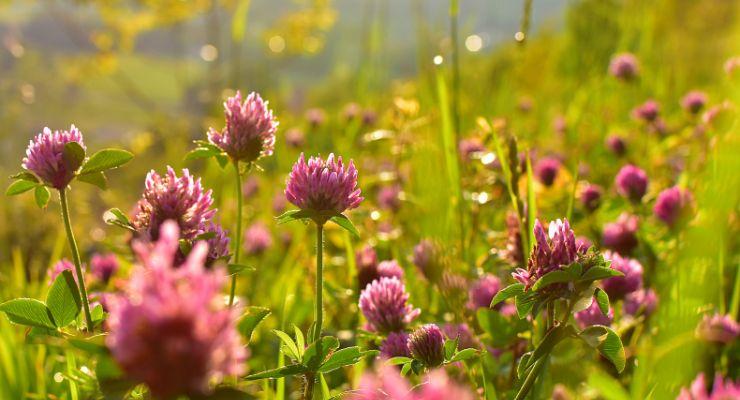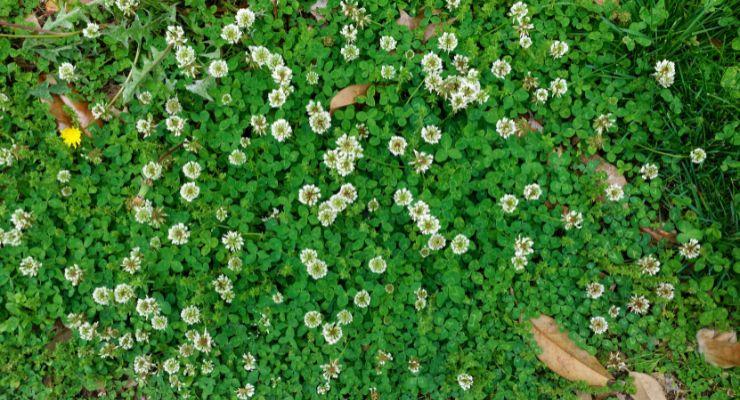Clover is a low-growing herbaceous plant that is often considered a weed in lawns. It has small, white, or pink flowers and is often found growing in dense patches.
Clover can be unattractive on a lawn and can also reduce the amount of sunlight and water available to the grass. Additionally, clover can produce a sticky, sap-like substance that can be a problem for pets and children who come into contact with it.
In this blog post, we will cover both non-chemical and chemical methods how to kill clover on a lawn. We will also discuss maintenance practices that can help prevent clover from returning. Whether you are looking for a natural solution or prefer to use chemicals, we have you covered with information on the most effective methods on how to get rid of clover in your lawn.
Understanding Clover
Physical characteristics
Clover is a type of weed that is commonly found in lawns. It is a low-growing plant with white or yellow flowers that is recognizable by its small, round leaves. Clover has a creeping growth habit and is often able to spread quickly, choking out the surrounding grass.
Growth habits
Clover has a creeping growth habit and is often able to spread quickly, choking out the surrounding grass. It grows best in moist conditions and can survive well even when the grass is dry or damaged. Clover also has an extensive root system that makes it difficult to remove.
How clover affects lawns
While clover can add nitrogen to the soil, improving the health of the lawn, it is often not desired by homeowners because it is not a typical component of a well-manicured lawn. Additionally, clover can create a bumpy surface and is difficult to mow. For these reasons, many people prefer to remove clover from their lawns.
However, clover has some benefits that are worth considering before deciding to eliminate it from your lawn. For example, clover is highly tolerant of low mowing heights and shade, making it ideal for lawns that are difficult to maintain.
Additionally, clover has a deep root system that can help to conserve water, reduce erosion, and improve soil structure.
It is important to understand the growth habits and characteristics of clover in order to effectively remove it from your lawn.

How to get rid of Clover with Non-Chemical Methods
Physical removal
This method involves manually pulling out the clover from the lawn. This is an effective method for small infestations, but it can be time-consuming and may not be feasible for large areas.
Encouraging grass growth
By improving the growing conditions of your lawn, you can help to reduce the spread of clover. This can be achieved by regularly mowing the lawn, watering it properly, and fertilizing it regularly with a balanced fertilizer.
Choosing shade-tolerant grass varieties
Clover thrives in shaded areas where the grass is typically weaker. By choosing shade-tolerant grass seed varieties, you can reduce the spread of clover in these areas and promote healthy grass growth.
Deprive It of oxygen and sunlight
Clover needs oxygen and sunlight to grow, so depriving it of both can help kill the clover. This can be done by adding a thick layer of mulch or compost around the affected area to block out the sun and reduce air circulation.
Vinegar solution
Use a spray bottle to make a solution that is one part vinegar and four parts water. Spray it directly onto the clover can help kill it.
Let your grass grow a little taller
Allowing your grass to grow a little taller than usual can also be helpful in killing off clover as it will block out some of the sunlight that the clover needs to thrive. Additionally, tall grass can help to prevent new clover from taking hold.
Use organic herbicide
Organic herbicides, such as those based on citric acid and clove oil, can be used to kill off clover. These are generally safe for the environment, but still require precautions to prevent runoff into local waterways. Additionally, these products can be expensive and may not be effective for large infestations.

Pros and cons of non-chemical methods
Non-chemical methods are an environmentally friendly way of controlling clover in a lawn. They are also cost-effective and safe for humans and pets.
Nonetheless, these procedures can be quite time-consuming and may not always provide the desired result in cases of large-scale clover infestations. Additionally, it may take several weeks or months for the grass to establish itself and for the clover to completely disappear.
Chemical Methods
One of the most effective ways to kill clover in a lawn is through the use of herbicides. There are several types of herbicides that are specifically designed to target clover, and these can be applied in different ways depending on the size of the affected area.
Some of the most common types of herbicides for clover control include pre-emergent and post-emergent herbicides. Pre-emergent herbicides are applied to the soil before the clover seeds have a chance to germinate, while post-emergent herbicides are applied to the existing clover plants to kill them.
The mode of action of these herbicides varies, but they all work by targeting specific processes in the clover plant. Some herbicides inhibit the clover plant’s ability to absorb essential nutrients, while others interfere with the plant’s photosynthesis or root development.
When applying herbicides, it is important to follow the manufacturer’s instructions and take precautions to avoid harming other plants or the environment.
It is also important to consider the potential risks and benefits of using chemicals to control clover in your lawn. While herbicides can effectively kill clover, they may also have negative effects on the environment, wildlife, and other non-target plants.
Additionally, repeated use of herbicides can lead to the development of resistant clover populations. On the other hand, using herbicides can quickly solve the problem of clover in your lawn and help you achieve a healthy, clover-free lawn.
Lawn Maintenance to Prevent Clover Growth
Mowing practices
Proper mowing practices can play a key role in preventing broadleaf weeds, like clover from taking over your lawn. It is recommended to mow your lawn frequently enough to remove no more than one-third of the grass height in any given mowing. This helps maintain a healthy root system and prevents weed seeds from germinating.
Effects of different mowing heights on clover and grass growth
Mowing too low can put stress on the grass and make it more susceptible to weed invasions, including clover. On the other hand, mowing too high can allow clover to grow freely and take over the lawn. A recommended mowing height for most lawns is 2 to 3 inches.
Watering and fertilization
Over-watering and over-fertilizing can create the ideal conditions for clover to grow and thrive in your lawn. It is important to water your lawn deeply but infrequently and to fertilize it only when necessary, following the manufacturer’s recommendations.
Optimal watering and fertilization methods for a lawn
Optimal watering and fertilization methods depend on the type of grass on your lawn and the climate you live in. A soil test can help you determine the right balance of nutrients for your lawn, and a local nursery or landscaper can recommend the best watering and fertilization practices for your area.
Minimizing soil compaction
Soil compaction can make it difficult for grass roots to penetrate the soil, leaving the way open for clover and other weed seeds to take root. To minimize soil compaction, it is important to avoid heavy foot traffic on the lawn and to aerate the soil every few years to allow water, air, and nutrients to penetrate more deeply.

Frequently Asked Questions
How to kill clover in flower beds?
Hand-pulling clover from the flower bed is one of the most effective non-chemical methods for killing clover. Be sure to remove as much of the root system as possible to prevent regrowth. However, killing clover in flower beds may require a different approach than killing clover in a lawn. For example, mulching the flower bed can help smother clover and prevent it from germinating. Use a thick layer of mulch to cover the soil surface.
Can clover return after being killed?
Yes, clover can return after being killed if the root system remains intact or if new seeds germinate. It’s important to follow the recommended methods for killing clover and to engage in proper lawn maintenance practices, giving a soil organic fertilizer (like corn gluten meal) and plenty of water, to minimize the chances of clover returning. However, with the right approach and resources, it’s possible to achieve a clover-free lawn and prevent clovers from coming back.
How do I know if my lawn has clover and not a different weed?
To determine if your lawn has clover or a different weed, you’ll need to examine the plant closely and compare it to images and descriptions of clover. Here are some key characteristics to look for:
Leaf Shape: Clover leaves are trifoliate, meaning they are made up of three leaves per stem. They are often round and have a slightly shiny appearance.
Flower Color: Clover has small, white, or pink flowers that are usually about 1/3 inch in diameter.
Growth Habit: Clover is a low-growing weed that spreads horizontally and can form dense mats.
Root System: Clover has a shallow root system that makes it easy to hand-pull.
If you’re still unsure if your lawn has clover or another weed, you can also bring a sample of the plant to your local garden center or agricultural extension office for identification.
Conclusion
Getting rid of clover in your lawn can be a challenge, but with the right approach, it’s possible to achieve a healthy, clover-free yard. Clover is a common weed that can affect the appearance and health of a lawn, but there are a variety of methods available to control it.
Homeowners can choose from non-chemical methods, such as physical removal and encouraging grass growth, or chemical methods like using herbicides.
To keep clover from coming back, it’s important to be proactive and engage in proper maintenance practices like mowing, watering, and fertilizing.
To achieve a beautiful, weed-free lawn with minimal effort and planning required is possible. Local gardening centers, agricultural extension offices, and online resources offer homeowners valuable information to maintain their ideal outdoor space. With the right guidance, controlling clover can be done successfully and result in an impressive landscape of green grass!

